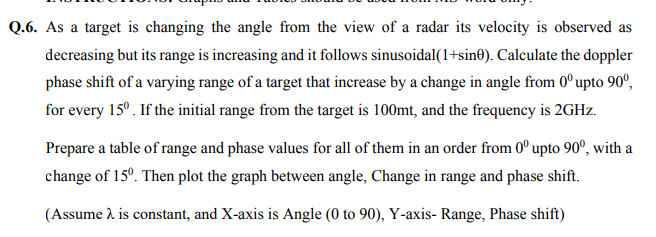Q.6. As a target is changing the angle from the view of a radar its velocity is observed as decreasing but its range is increasing and it follows sinusoidal(1+sin®). Calculate the doppler phase shift of a varying range of a target that increase by a change in angle from 0° upto 90°, for every 15°. If the initial range from the target is 100mt, and the frequency is 2GHZ. Prepare a table of range and phase values for all of them in an order from 0° upto 90°, with a change of 15°. Then plot the graph between angle, Change in range and phase shift. (Assume à is constant, and X-axis is Angle (0 to 90), Y-axis- Range, Phase shift)
Q.6. As a target is changing the angle from the view of a radar its velocity is observed as decreasing but its range is increasing and it follows sinusoidal(1+sin®). Calculate the doppler phase shift of a varying range of a target that increase by a change in angle from 0° upto 90°, for every 15°. If the initial range from the target is 100mt, and the frequency is 2GHZ. Prepare a table of range and phase values for all of them in an order from 0° upto 90°, with a change of 15°. Then plot the graph between angle, Change in range and phase shift. (Assume à is constant, and X-axis is Angle (0 to 90), Y-axis- Range, Phase shift)
Related questions
Question

Transcribed Image Text:Q.6. As a target is changing the angle from the view of a radar its velocity is observed as
decreasing but its range is increasing and it follows sinusoidal(1+sin®). Calculate the doppler
phase shift of a varying range of a target that increase by a change in angle from 0° upto 90°,
for every 15°. If the initial range from the target is 100mt, and the frequency is 2GHZ.
Prepare a table of range and phase values for all of them in an order from 0° upto 90°, with a
change of 15°. Then plot the graph between angle, Change in range and phase shift.
(Assume à is constant, and X-axis is Angle (0 to 90), Y-axis- Range, Phase shift)
Expert Solution
This question has been solved!
Explore an expertly crafted, step-by-step solution for a thorough understanding of key concepts.
Step by step
Solved in 6 steps with 6 images
